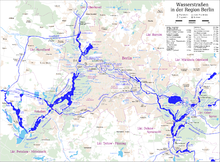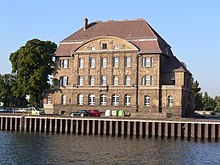Osthafen (Berlin)
The Osthafen is a former industrial port on the Spree in Berlin that went into operation in 1913 . Stralauer Allee runs along it . Today, various media companies have their headquarters on the site. Conspicuous buildings are the so-called egg cold store , the Osthafenspeicher and, further to the east, two symmetrically arranged two-storey former warehouses with a three-storey administration building in between and the three-storey former canteen , the "worker's dining house".
history
Due to the sharp increase in shipping traffic on Berlin's waterways towards the end of the 19th century, the only urban transshipment point, the Urbanhafen in the Landwehr Canal , was no longer sufficient. At the request of city planning officer James Hobrecht , the elders of the merchants submitted a memorandum on November 18, 1895. This contained the proposal to build two large transshipment points with storage buildings in Berlin, one in the west and one in the east.
Hobrecht's successor in office, Friedrich Krause , presented his design for the east port in 1899. He had chosen the as yet undeveloped Stralauer Anger, more than half of which belonged to the city of Berlin. Among other things, there were already storage areas, a bathing establishment and one of the three rubbish dumps in the city of Berlin on the site. The proximity to the Ringbahn offered itself for a rail connection. The port was well connected in all directions by cart , also thanks to the Oberbaum Bridge . At that time, the plans were already for the warehouses, which are still standing today, with the two administrative and farm buildings in between, railway tracks, straightening of the Spree with a 1.4 kilometer long quay wall , locomotive shed, underground petrol tank farm and a separate power station on the Ringbahn. A three-part storage building was also planned at the Oberbaum Bridge. The building color should be gray so as not to compete with the Oberbaum Bridge and the buildings of the Auergesellschaft (today's Oberbaum City ), but also so that the dust generated by the port operations was not so noticeable.
Another eight years followed, during which the political and economic framework conditions were clarified. On June 22, 1905, the city council approved the Osthafen, but no financial resources were made available. It was not until September 6, 1907, after the planned costs of 2.456 million marks (adjusted for purchasing power in today's currency: around 15 million euros) for the first phase of construction had been approved, that the first sod was broken . Due to various land and jurisdiction disputes, there were already several years of construction delays at the end of 1908. Construction did not continue until mid-1910 and Friedrich Krause inaugurated the port on September 28, 1913. More than 17 million marks had been built.
Data on the size and performance of the port at that time:
- Grain and goods storage: 3000 m² floor space, storage facilities for 15,400 tons of grain and 10,200 tons of other goods
- two warehouses with a floor area of 2500 m² each
- three free stores for coal, merchandise and bricks
- two grain elevators
- several mobile cranes
- Conveyor belts, elevators, hatch winches
- The quays can be moored: up to 40 ships with a load capacity of 600 tons each, alternatively 76 Finow barges


It was not until 1923, with the opening of the western port, that the size of the eastern port was exceeded. In this context, the management of the Osthafen was transferred to the then newly founded Berliner Hafen- und Lagerhaus AG , or BEHALA for short . Furthermore, the east port experienced a heavy use. In 1930 the annual turnover of goods was 2.3 million tons. From 1928 to 1929 the so-called egg cold store was built according to a design by Oskar Pusch .
During the Second World War , the port also served the Wehrmacht as a cargo handling point; more than 150 prisoners of war and foreign workers worked on the site. After the war, around 80 percent of the buildings and the port area were destroyed. On April 24, 1945, the port was occupied by the Red Army , the existing goods were confiscated as booty and transported away in the summer. Until 1947, large areas were confiscated and used by the Soviets , and the mobile loading bridge was dismantled.
After the war, in addition to transporting reparations and dismantling goods , the port was mainly used for handling urgently needed food. In 1948 the Osthafen, together with part of the Humboldhafen, came under the administration of the East Berlin magistrate , and from April 1961 onwards, it came to the district directorate for motor traffic. From 1969 it was subordinate to the VE Kombinat Auto Trans Berlin , from January 1, 1988 the VEB Binnenhafen Berlin belonged to the VE Kombinat inland shipping and waterways . Due to its location in the border area between East and West Berlin , traffic was severely hindered, with the construction of the Elsen Bridge from 1965 to 1968 it lost part of its open space. Nonetheless, the turnover of goods rose steadily at this time too, from 1969 to 1989 between 2.2 and 2.8 million tons of goods were handled there annually, from 1971, with the acceleration of housing construction in East Berlin, mainly building materials.
Todays situation

In the course of German reunification , the border security systems in the Osthafen became superfluous, and on January 1, 1992, it was reintegrated into BEHALA. In 1997, 35 dock workers and around 250 freight forwarders were employed on the site. Five cranes, 14 forklifts and four electric locomotives did their job. Two concrete mixing plants were established. The power plant building, restored in 1993, was rented to the Neues Deutschland publishing house until 2005 . In the mid-1990s there were plans to convert the buildings. The egg cold store has been restored and has been the headquarters of Universal Music since 2002 . The Osthafenspeicher, which had a partially destroyed roof for a long time, was also restored and is now the seat of several media companies. From April 2004, MTV moved into the western of the two symmetrically arranged warehouses (Stralauer Allee 7). Much of the site is now a media and fashion location in particular.
In 2006/2007, after extensive renovation , the Labels Berlin 1 fashion center was initially relocated to “Warehouse 2” . Well-known fashion brands work here, such as B. Hugo Boss , Tom Tailor and Esprit under one roof. In 2009/2010, a new five-story building with a steel and glass facade and an abstraction made of concrete around it, which looks like items of laundry on a line, was built on the free space next to it. The building, which opened in January 2010, operates under the Berlin 2 label and has become the headquarters for young brands and manufacturers of streetwear . On the ground floor, Roof GmbH & Co. KG operates the Labels2 event area and a catering service. In March 2012, both buildings, labels Berlin 1 and 2, were transferred to the investment company SEF Select Evolution 1 Ltd. & Co. KG has been sold. The new fashion center on the Osthafen area is to be completed by another building, Labels Berlin 3 , the completion date of which has not yet been set.
The RTL-2 television series Berlin - Day & Night is set at the Osthafen. The studio of the ZDFneo broadcast NeoParadise with Joko Winterscheidt and Klaas Heufer-Umlauf is also located here .
The crossing of the Spree to expand the Berlin city ring to Friedrichshain is planned between the Elsenbrücke and the railway bridges. According to the current state of planning, the old power station building would have to give way to this motorway construction.
Opposite - in the former border control port of the GDR - lies the wreck of the former excursion ship Dr. Ingrid Wengler .
urban planning
In the official zoning plan of the Senate Department for Urban Development, the term “port” was formally removed as early as 2002: “The lettering“ port ”has been dropped. The development of building areas is possible south of Stralauer Allee. ”Currently (as of 2012) the Waterways and Shipping Office is operating a process of expressing interest in order to make the“ water area opposite the former East Harbor ”(official name) usable again for shipping as a port.
See also
literature
- Zaar: The new east port in Berlin . In: Deutsche Bauzeitung , 1914, pp. 719–722, 727–729, 736–740, 747–750.
- Maria Curter: The Osthafen through the ages . In: Berlin monthly magazine ( Luisenstädtischer Bildungsverein ) . Issue 9, 1997, ISSN 0944-5560 , p. 20-29 ( luise-berlin.de ).
Web links
- Entry in the Berlin State Monument List with further information
- Excerpt from Berlin: Open City - The Guide . Nicolai-Verlag, Berlin
- Information sheet on the Osthafen. (PDF) Berlin Center for Industrial Culture
Individual evidence
- ↑ Alexandra Maschewski: MTV moved in at the Osthafen . In: Berliner Morgenpost , April 24, 2005
- ↑ Kirsten Niemann: Forum for Young Brands . In: Berliner Zeitung , January 20, 2010
- ↑ Michael Bartnik: The Titanic from the Spree . In: Berliner Zeitung , July 2005
Coordinates: 52 ° 29 ′ 57 ″ N , 13 ° 27 ′ 24 ″ E







